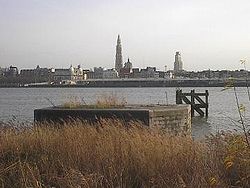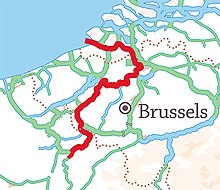Scheldt
This article needs additional citations for verification. (August 2018) |
| Scheldt | |
|---|---|
 The Scheldt in Antwerp | |
 Course of the Scheldt | |
| Native name | |
| Location | |
| Countries |
|
| Physical characteristics | |
| Source | |
| • location | France |
| • elevation | 97 m (318 ft) |
| Mouth | |
• location | North Sea |
• coordinates | 51°25′51″N 3°31′44″E / 51.43083°N 3.52889°E |
| Length | 360 km (220 mi) |
| Basin size | 21,863 km2 (8,441 sq mi) |
| Discharge | |
| • average | 104 m3/s (3,700 cu ft/s) |
| Official name | Schorren van de Beneden Schelde |
| Designated | 4 March 1986 |
| Reference no. | 327[1] |
| Official name | Westerschelde & Saeftinghe |
| Designated | 9 April 1995 |
| Reference no. | 748[2] |
| Official name | Vallées de la Scarpe et de l'Escaut |
| Designated | 2 February 2020 |
| Reference no. | 2405[3] |
The Scheldt (/ˈʃɛlt, ˈskɛlt/ SHELT, SKELT; French: Escaut [ɛsko]; Dutch: Schelde [ˈsxɛldə] ⓘ) is a 435-kilometre-long (270 mi)[4] river that flows through northern France, western Belgium, and the southwestern part of the Netherlands, with its mouth at the North Sea. Its name is derived from an adjective corresponding to Old English sċeald ("shallow"), Modern English shoal, Low German schol, West Frisian skol, and obsolete Swedish skäll ("thin").[citation needed]
Course
The headwaters of the Scheldt are in Gouy, in the Aisne department of northern France. It flows north through Cambrai and Valenciennes, and enters Belgium near Tournai. Ghent developed at the confluence of the Lys, one of its main tributaries, and the Scheldt, which then turns east. Near Antwerp, the largest city on its banks, the Scheldt flows west into the Netherlands toward the North Sea.[citation needed]
Originally there were two branches from that point: the
The Scheldt is an important
The Scheldt flows through the following departments of France, provinces of Belgium, provinces of the Netherlands, and towns:[citation needed]
- Aisne (F): Gouy
- Hainaut (B): Tournai
- West Flanders (B): Avelgem
- East Flanders (B): Oudenaarde, Ghent, Dendermonde, Temse
- Antwerp (B): Antwerp
- Zeeland (NL): Hulst, Terneuzen, Sluis, Vlissingen
History




The Scheldt estuary has always had considerable commercial and strategic importance. Called Scaldis in
This status quo remained intact, at least on paper, until 1528, but by then, both the
Access to the river was the subject of the brief
The Question of the Scheldt, a study providing "a history of the international legal arrangements governing the Western Scheldt", was prepared for the use of British negotiators at the Treaty of Versailles in 1919.[6]
In the
Tributaries and sub-tributaries

- Western Scheldt or Honte (Vlissingen)
- Schijn (Antwerp)
- Rupel (Rupelmonde)
- Nete (Rumst)
- Kleine Nete (Lier)
- Aa (Grobbendonk)
- Wamp (Kasterlee)
- Grote Nete (Lier)
- Wimp (Herenthout)
- Molse Nete (Geel)
- Laak (Westerlo)
- Dijle (Rumst)
- Zenne (Mechelen)
- Maalbeek (Grimbergen)
- Woluwe (Vilvoorde)
- Maalbeek (Schaerbeek)
- Molenbeek (Brussels-Laeken)
- Neerpedebeek (Anderlecht-Neerpede)
- Zuun (Sint-Pieters-Leeuw-Zuun)
- Geleytsbeek (Drogenbos)
- Linkebeek (Drogenbos)
- Molenbeek (Lot)
- Senette (Tubize)
- Vrouwvliet (Mechelen) [further upstream named Grote Beek, Meerloop, Raambeek, Zwartwaterbeek, Boeimeer]
- Demer (Rotselaar)
- Voer (Leuven)
- IJse (Huldenberg-Neerijse)
- Nethen (Grez-Doiceau-Nethen)
- Laan (Huldenberg-Terlanen-Sint-Agatha-Rode)
- Zilverbeek (Rixensart-Genval)
- Thyle (Ottignies-Louvain-la-Neuve)
- Nete (Rumst)
- Durme (Temse)
- Molenbeek (Wichelen)
- Dender (Dendermonde)
- Mark (Lessines-Twee-Akren)
- Ruisseau d'Ancre (Lessines)
- Zulle (Ath)
- Eastern Dender (Ath)
- Western Dender (Ath)
- Hofstade)
- Lys/Leie (Ghent)
- Zwalm (Zwalm)
- Rone (Kluisbergen)
- Scarpe (Mortagne-du-Nord)[8]
- Haine (Condé-sur-l'Escaut)
- Trouille (Mons-Jeumont)
- Hogneau of Honneau (Condé-sur-l'Escaut)
- Honelle (Quiévrain)
- Aunelle (..)
- Grande Honelle (..)
- Petite Honelle (..)
- Honelle (Quiévrain)
- Rhonelle (Valenciennes)
- Écaillon (Thiant)[8]
- Selle (Denain)[8]
- Torrent d'Esnes
- Sensée (Bouchain)[8]
- Hirondelle (..)
- Erclin (Iwuy)
- Eauette (Marcoing)

Canalisation from Cambrai down to Valenciennes was completed in 1788. Napoleon saw the benefits of linking Paris to Belgium and accelerated completion of the Canal de Saint-Quentin to the south. The locks were deepened and doubled, as coal became the essential commodity of the industrial revolution. Upgrading downstream from Bouchain was started in the 1960s in both France and Flanders, but the waterway is still not fully compliant with European standards. All the locks on the high-capacity section are being doubled by European Class Vb size locks, 185 by 12 m (607 by 39 ft), as part of the overall European Seine-Scheldt waterway project.[9] The Pont des Trous, a listed fortified bridge in Tournai that has already been substantially modified, will again be raised to provide the necessary dimensions, including an air draught of 7.10 m (23 ft 4 in).[citation needed]
The 13 km section between Cambrai (connection with Canal de Saint-Quentin) and Hordain (connection with Canal de la Sensée) is only navigable for small ships (péniche) and has 5 locks.[10]
In culture
Traditions says that Saint Amalberga of Temse crossed the river in Temse on the back of a big Sturgeon.[citation needed]
See also
- Scheldt–Rhine Canal
- Striene which was the main stem of the river until 1421, it flowed northwards.
- Zeeschelde
- Zwalm (River)
References
- ^ "Schorren van de Beneden Schelde". Ramsar Sites Information Service. Retrieved 25 April 2018.
- ^ "Westerschelde & Saeftinghe". Ramsar Sites Information Service. Retrieved 25 April 2018.
- ^ "Vallées de la Scarpe et de l'Escaut". Ramsar Sites Information Service. Retrieved 3 February 2020.
- ^ "VNSC Communicatie : vraagbaak voor alles op, rond en in de Schelde" (in Dutch). Retrieved 2014-06-03.
- ^ "Avalon Project - Belgian-American Diplomacy - Convention for the Extinguishment of the Scheldt Dues: July 20, 1863". avalon.law.yale.edu. Retrieved 2023-05-18.
- ^ Prothero, G W (1920). Question of the Scheldt. Peace handbooks. London: H.M. Stationery Office. Retrieved 2014-06-03.
- ISBN 978-1771620307.
- ^ .
- ISBN 978-1-846230-14-1.
- ^ Fluviacarte, Escaut (à petit gabarit)
External links
- Water basin of the Scheldt
- www.scheldenet.nl
- ScheldeMonitor; Research studies and monitoring activities
- Deltaworks; Flood protection works in Scheldt Delta
- International Scheldt Commission
- Scaldit - Interreg IV B NWE project for a safer and cleaner Scheldt River Basin District (FR - BE (Walloon Region - Brussels Cap. Region - Flemish Region) - NL)
- Bibliography on Water Resources and International Law Peace Palace Library
- River Escaut with maps and details of places, ports and moorings, by the author of Inland Waterways of France, Imray
- Navigation details for 80 French rivers and canals (French waterways website section)
 Texts on Wikisource:
Texts on Wikisource:
- "Scheldt". Collier's New Encyclopedia. 1921.
- "Scheldt". Encyclopædia Britannica (11th ed.). 1911.
- "Scheldt". The Nuttall Encyclopædia. 1907.
- Paget-Tyrell Memorandum of August 7, 1916, Section 6 (Belgium and the Scheldt)



